I often get these questions: Has my sauerkraut gone bad? Is my sauerkraut safe to eat? How will I know? Let’s look inside my refrigerator and see if there’s some sauerkraut there that is not fit for consumption.
Looking for Jars of Bad Sauerkraut
It was the beginning of December 2014. I had just lifted the lid on the first batch of sauerkraut (Kimchi Style Sauerkraut) that I had fermented in my new 3-gallon Ohio Stoneware Fermentation Crock. I packed its contents into 13 1-quart jars – WOW! that crock holds a lot – and soon realized there was not enough room in my refrigerator for storing it. Time to do some clean-up and culling.
I’m lucky to have a second refrigerator in my garage. It’s where bags of fall farmer’s market finds get stashed: cabbage (in the white plastic bags), carrots, beets and apples, olive oil, wheels of bulk-purchased raw Gouda cheese, along with many jars of sauerkraut. On those 2 shelves are 18 jars of various flavors of sauerkraut: Dill, Kimchi and Sweet Garlic. Ah, the power of making sauerkraut in large crocks, but that’s for another blog post.
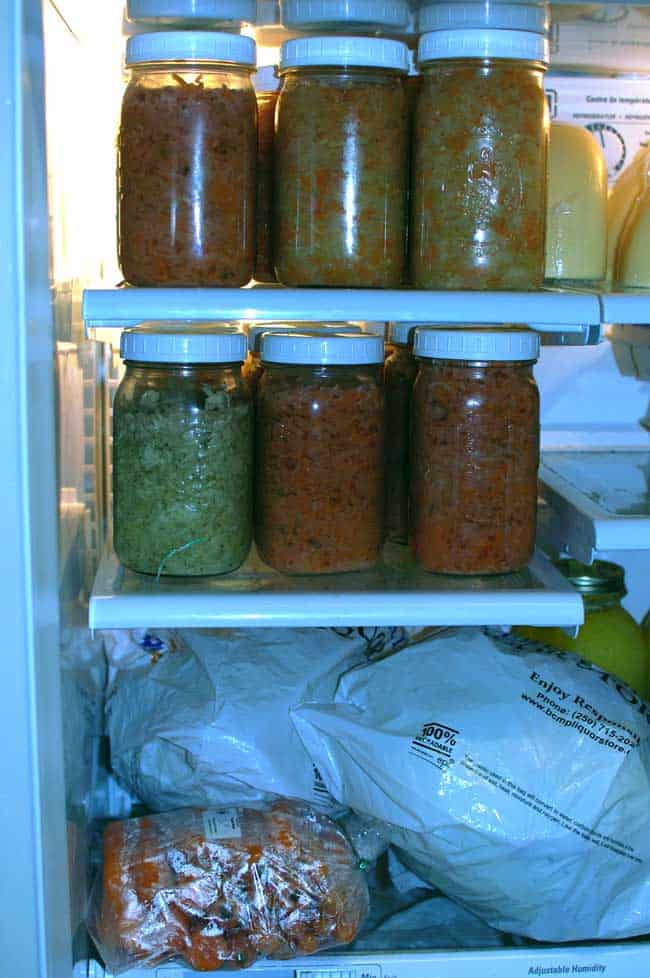 To make room, I started looking for jars of sauerkraut I knew I would never eat but hadn’t had the heart to throw out earlier. Here are 5 jars of sauerkraut I found – hanging out on the door of the refrigerator – that were old and were not being consumed.
To make room, I started looking for jars of sauerkraut I knew I would never eat but hadn’t had the heart to throw out earlier. Here are 5 jars of sauerkraut I found – hanging out on the door of the refrigerator – that were old and were not being consumed.
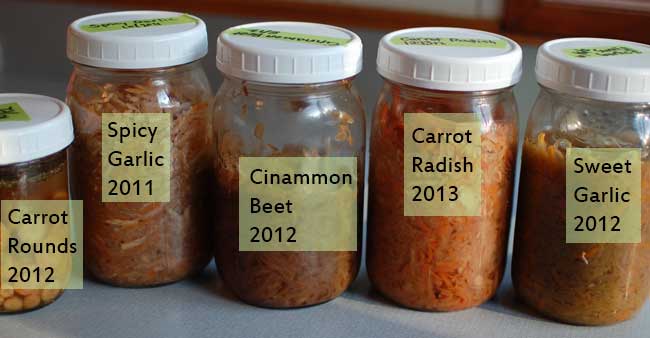 Out went the Spicy Garlic Sauerkraut from 2011. Brown, too spicy for me; the heaping teaspoon of red pepper flakes in it left my mouth flaming.
Out went the Spicy Garlic Sauerkraut from 2011. Brown, too spicy for me; the heaping teaspoon of red pepper flakes in it left my mouth flaming.
Next to dump into my bowl for the compost heap was Cinnamon Beet Sauerkraut from 2012. Good flavor but the beautiful vibrant-red color in the beets was long gone.
Carrot Radish Sauerkraut (2013) was a failed flavor attempt at “clean out the refrigerator of leftover vegetables.” And, I knew I would never eat the Sweet Garlic Sauerkraut from 2012 when I had more than a dozen 2014 jars already in my refrigerator; so that also was fed to the worms.
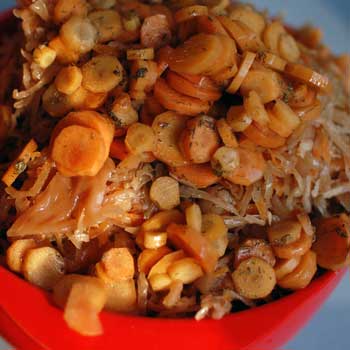
Last to dump – of the edible, but not pretty stuff – were the brined Garlic Carrot Rounds. My family just never ate them. I sampled a few; they tasted just fine but I had to make room for the 2014-2015 harvest!
I started moving jars around to fit the new jars in and found one last jar.
The jar labeled “10/11” indicated it was over 3-years old and had to go. But, in a way I was proud of that jar. It was my first jar of sauerkraut that definitely “DID NOT LOOK NOR SMELL EDIBLE.” This is one spoiled jar in 10-plus years of making sauerkraut! Yes, I’ve thrown out some slimy sauerkraut, when I fermented with too many high sugar vegetables and have had some mold pockets in my early days of fermenting before I was weighing ingredients and using a specific brine ratio, but this jar was different.
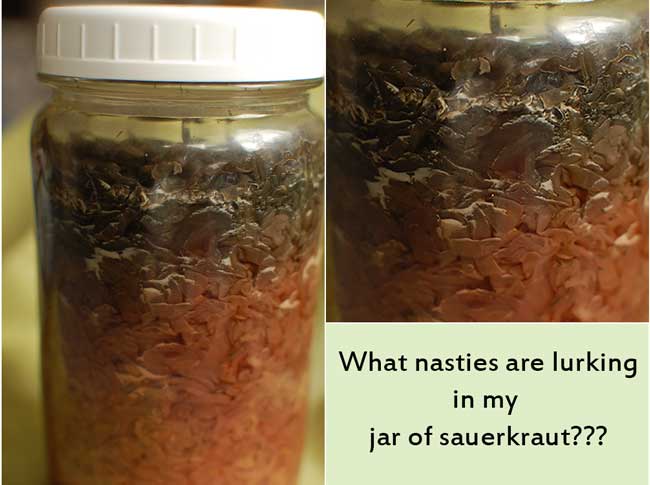 There were strange creamy-white threads of who-knows-what working their way along the top layers. I had put my son’s name on the label, to indicate he grew the cabbage and “Red, Dill” for the type of cabbage and flavor. I knew it was time to toss it but first, I opened the lid. Strong, alcohol-like vapors knocked my socks off. What happened? My guess? A causality of “double-dipping!”
There were strange creamy-white threads of who-knows-what working their way along the top layers. I had put my son’s name on the label, to indicate he grew the cabbage and “Red, Dill” for the type of cabbage and flavor. I knew it was time to toss it but first, I opened the lid. Strong, alcohol-like vapors knocked my socks off. What happened? My guess? A causality of “double-dipping!”
Double-dipping is the act of dipping your personal fork into the jar to serve yourself. A “dirty” fork introduces unknown bacteria into the ferment. We had eaten just a litlle out of this jar and then forgot about it… for years. leaving plenty of time for the bad bacteria (off our forks?) to do their dirty work.
Or, perhaps I did not use enough salt to create a healthy brine ratio. I’ll never know the real reason for the demise of that jar of Red Dill Sauerkraut, but it’s the only jar of sauerkraut in my dozen plus years of fermenting, that was definitely not edible.
Has My Sauerkraut Gone Bad?
Most likely not. But, it might not have maximum nutritional levels.
Browned Sauerkraut
Look back at the labeled picture at the beginning of this post. What do you notice? The brined carrots and the 2013 sauerkraut have good color. The 2- and 3-year old jars from 2011 and 2012 have browned. These jars of sauerkraut all smelled fine and are safe to eat.
However, browning indicates oxygen has gotten to the cabbage and the Vitamin C content is low to nil where it is browned. This, according to Lea Harris over at Nourishing Treasures. Now, I don’t feel so guilty about tossing all those jars of sauerkraut.
But, I might consider adding brine before putting away my jars of sauerkraut that end up dry and not covered in brine. I hate to do this because I find it dilutes the flavors but if I want to maximize Vitamin C levels, I might have to.
The 1-year old Carrot Radish Sauerkraut still had good color, so maybe I just need to make sure to eat it within a year which fits in with the traditional food preservation process. Preserve the bountiful fall harvest to get through winter when locally available vegetables are scarce.
Visible Fuzz, Significant Mold, Pink Color, Smells Bad or Smell of Alcohol
My Red Dill Sauerkraut definitely falls under this category. Toss and learn from it what you can.
See Has Your Sauerkraut Fermentation Gone Bad: Three Fermentation Rules and Many Troubleshooting Tips for additional advice.
In closing, I offer you these words of encouragement: making lacto-fermented sauerkraut is a safe and easy way to create a delicious probiotic-rich food with numerous health benefits. The likelihood of something going wrong is minimal.
See The SureFire Sauerkraut Method… In a Jar: 7 Easy Steps for step-by-step instructions.
Do You Have a Jar of Sauerkraut that has Gone Bad? What Did You Throw Out?
Please share your experience in the Comments section below.

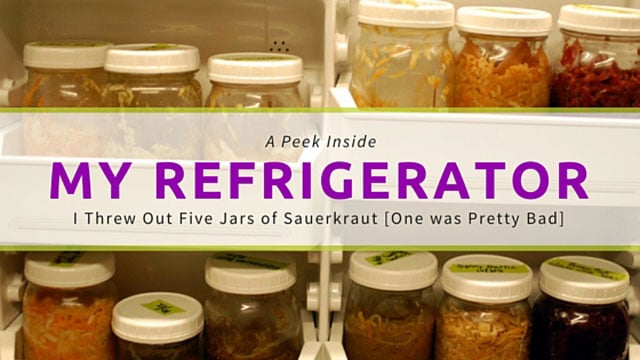

 This post may contain affiliate links which won’t change your price but will share some commission.
This post may contain affiliate links which won’t change your price but will share some commission.


